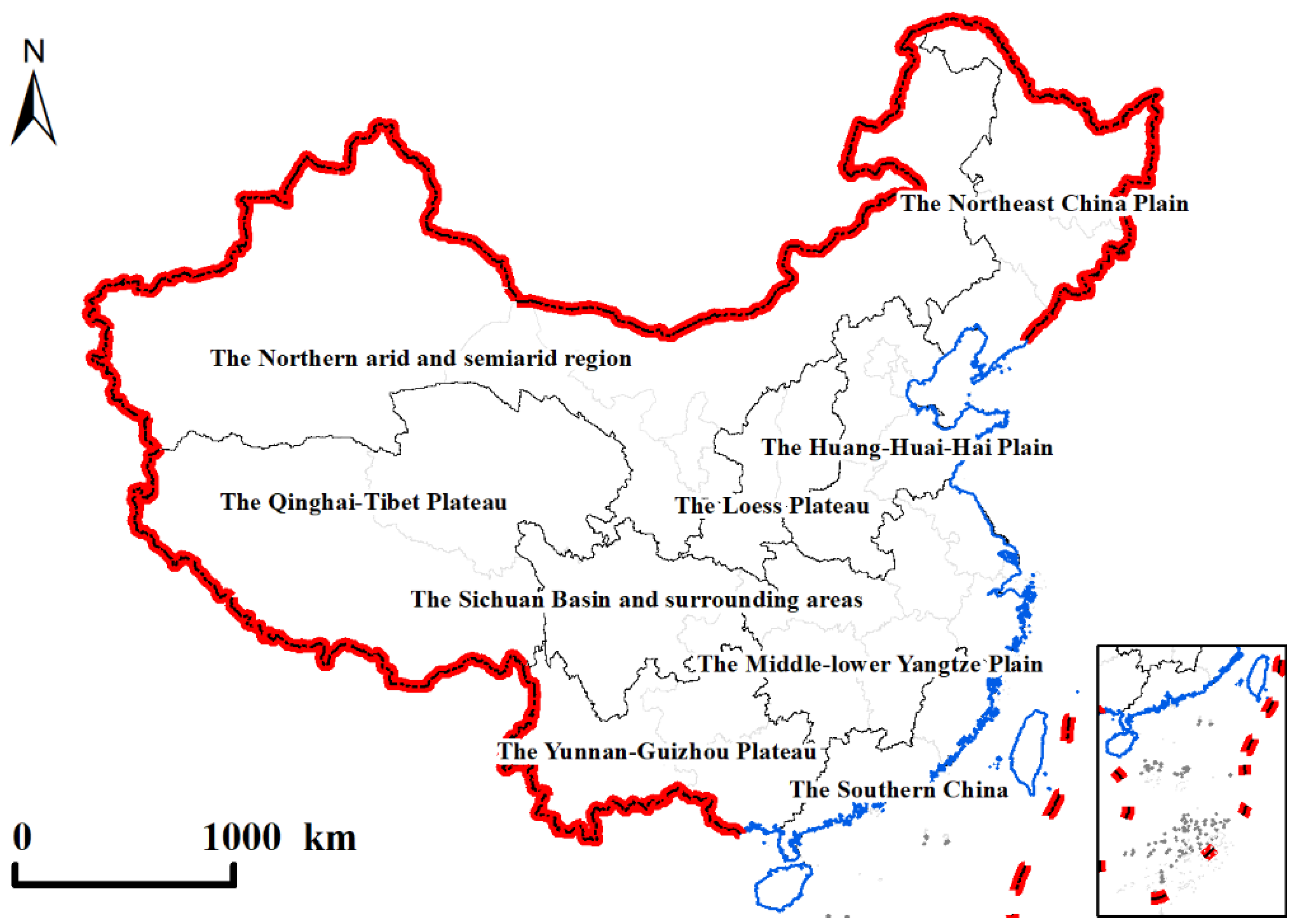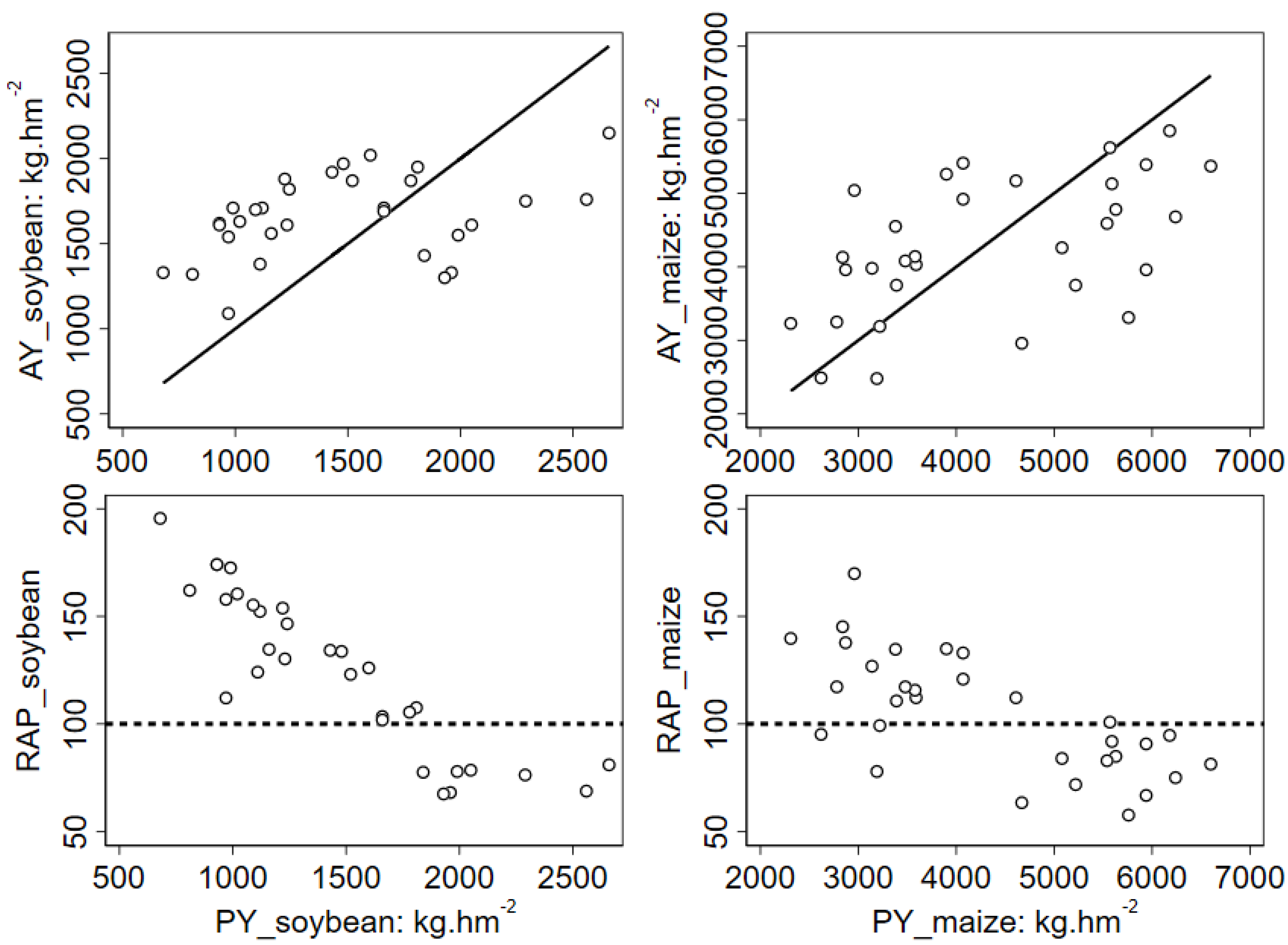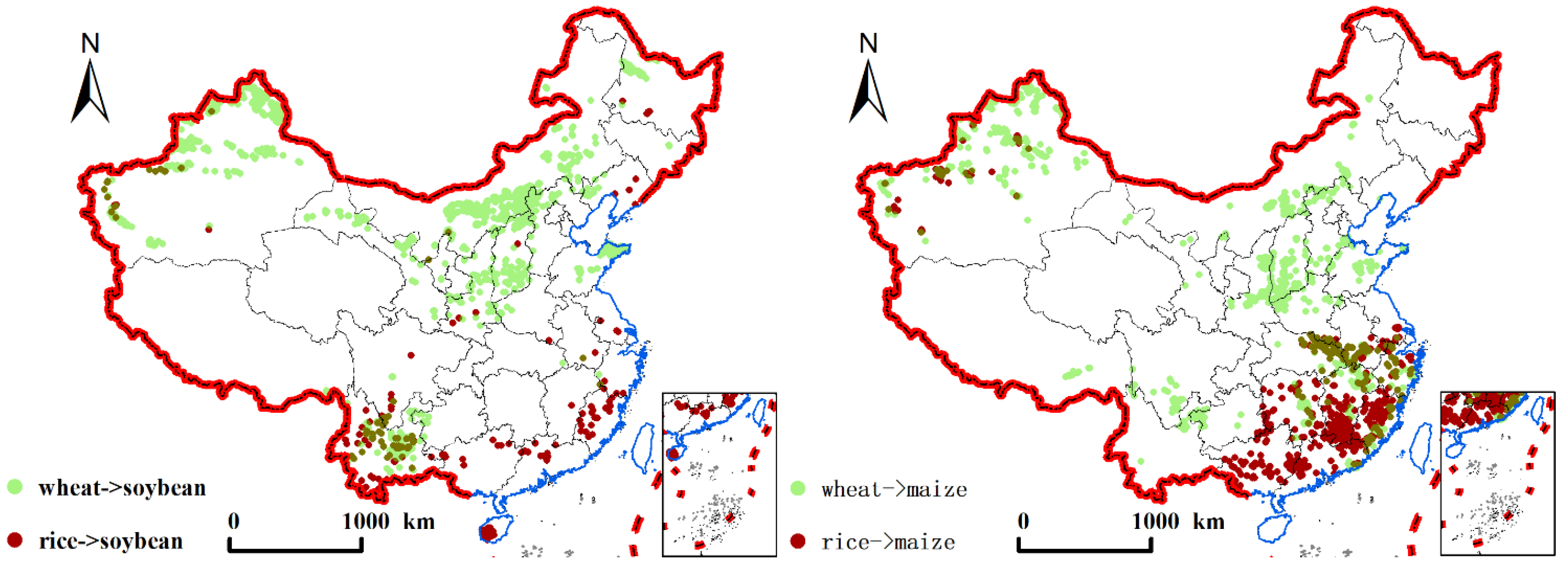Planting Structure Adjustment and Layout Optimization of Feed Grain and Food Grain in China Based on Productive Potentials
Abstract
1. Introduction
2. Construction of Model and Indexes
2.1. GAEZ Model
2.2. Yield Potential Development Coefficient
2.3. Yield Efficiency Advantage Index
2.4. Yield Efficiency Advantage Type Zoning
3. Results
3.1. Actual Yield and Yield Potential Development Coefficient Analysis of Feed Grain
3.1.1. Characteristics of RAP of Feed Crops in Provinces of the Chinese Mainland
3.1.2. Characteristics of RAP of Feed Crops in Different Agricultural Regions
3.2. Yield Efficiency Advantage Index and Planting Structural Layout Optimisation Schemes for Feed Grain
3.2.1. Spatial Pattern of Yield Efficiency Advantage Indexes of Feed Grain
3.2.2. Planting Layout Adjustment and Optimization Scheme of Feed Grain
3.2.3. Layout Adjustment and Optimization Schemes between Feed Grain and Food Grain
4. Discussion and Conclusions
4.1. Discussion
4.2. Conclusions
Funding
Institutional Review Board Statement
Informed Consent Statement
Data Availability Statement
Conflicts of Interest
References
- Zhou, Y.; Staatz, J. Projected demand and supply for various foods in West Africa: Implications for investments and food policy. Food Policy 2016, 61, 198–212. [Google Scholar] [CrossRef]
- He, C.; Liu, Z.; Min, X.; Ma, Q.; Dou, Y. Urban expansion brought stress to food security in China: Evidence from decreased cropland net primary productivity. Sci. Total Environ. 2017, 576, 660–670. [Google Scholar] [CrossRef] [PubMed]
- Spiertz, J.H.J.; Ewert, F. Crop production and resource use to meet the growing demand for food, feed and fuel: Opportunities and constraints. NJAS—Wagening. J. Life Sci. 2009, 56, 281–300. [Google Scholar] [CrossRef]
- Wang, Y.H. The Challenges and Strategies of Food Security under Rapid Urbanization in China. Sustainability 2019, 11, 542. [Google Scholar] [CrossRef]
- Coetzee, K. Pessimistic global agricultural outlook. Farmer’s Wkly 2018, 18029, 30. [Google Scholar]
- Huang, S.L.; Liu, A.M.; Lu, C.X. Supply and Demand Levels for Livestock and Poultry Products in the Chinese Mainland and the Potential Demand for Feed Grains. J. Resour. Ecol. 2020, 11, 475. [Google Scholar]
- Qiang, W.L.; Liu, A.; Cheng, S.K.; Kastner, T.; Xie, G.D. Agricultural trade and virtual land use: The case of China’s crop trade. Land Use Policy 2013, 33, 141–150. [Google Scholar] [CrossRef]
- Adewopo, J.B.; Gloria, S.H.; Colen, L.; Micale, F. Using crowd-sourced data for real-time monitoring of food prices during the COVID-19 pandemic: Insights from a pilot project in northern Nigeria. Glob. Food Secur. 2021, 29, 100523. [Google Scholar] [CrossRef]
- De, W.J.; Peersman, G. The Impact of Food Prices on Conflict Revisited. J. Bus. Econ. Stat. 2021, 39, 547–560. [Google Scholar]
- Yang, J.; Qiu, H.G.; Huang, J.K.; Rozelle, S. Fighting global food price rises in the developing world: The response of China and its effect on domestic and world markets. Agric. Econ. 2008, 30, 453–464. [Google Scholar] [CrossRef]
- Thennakoon, J.; Anderson, K. Could the proposed WTO Special Safeguard Mechanism protect farmers from low international prices? Food Policy 2015, 50, 106–113. [Google Scholar] [CrossRef]
- Zhan, S.H. The Political Economy of Food Import and Self-reliance in China: 1949–2019. Glob. Food Hist. 2022, 8, 194–212. [Google Scholar] [CrossRef]
- Wang, J.Y.; Zhang, Z.W.; Liu, Y.S. Spatial shifts in grain production increases in China and implications for food security. Land Use Policy 2018, 74, 204–213. [Google Scholar] [CrossRef]
- Avery, S.C.; Leah, K.V.; Stephanie, A.S.; John, F.M. Cropping frequency and area response to climate variability can exceed yield response. Nat. Clim. Change 2016, 6, 601–604. [Google Scholar]
- Jin, S.Q.; Zhou, F.Z. Growth of Chemical Fertilizer and Pesticide Use: China’s Objectives, Progress and Challenges. J. Resour. Ecol. 2018, 9, 50–58. [Google Scholar]
- Wang, J.X.; Jiang, Y.T.; Wang, H.M.; Huang, Q.Q.; Deng, H.B. Groundwater irrigation and management in northern China: Status, trends, and challenges. Int. J. Water Resour. Dev. 2020, 36, 670–696. [Google Scholar] [CrossRef]
- Feng, Y.N.; Wang, J.Y. Detecting the Spatial Mismatch of Water Resources and Grain Planting Pattern Changes in China Based on Satellite Data. Front. Environ. Sci. 2022, 10, 703. [Google Scholar] [CrossRef]
- Zhu, W.B.; Jia, S.F.; Devineni, N.; Lv, A.F.; Lall, U. Evaluating China’s Water Security for Food Production: The Role of Rainfall and Irrigation. Geophys. Res. Lett. 2019, 46, 11155–11166. [Google Scholar] [CrossRef]
- Wu, W.B.; Yu, Q.Y.; You, L.Z.; Chen, K.; Tang, H.J.; Liu, J.G. Global cropping intensity gaps: Increasing food production without cropland expansion. Land Use Policy 2018, 76, 515–525. [Google Scholar] [CrossRef]
- Li, J.; Xin, C.; Fei, L.; Pan, Z.H.; Niu, J.H.; Ding, C.Y.; Meng, L.J.; Zhang, G.L.; Mgeni, C.P.; Sieber, S.; et al. Spatial Distribution and Changes of the Realizable Triple Cropping System in China. Sustainability 2019, 11, 1–18. [Google Scholar]
- Li, T.T.; Wang, Y.F.; Liu, C.Q.; Tu, S.S. Research on Identification of Multiple Cropping Index of Farmland and Regional Optimization Scheme in China Based on NDVI Data. Land 2021, 10, 861. [Google Scholar] [CrossRef]
- Pittelkow, C.M.; Liang, X.; Linquist, B.A.; Groenigen, K.; Kessel, C.V. Productivity limits and potentials of the principles of conservation agriculture. Nature 2015, 517, 365–368. [Google Scholar] [CrossRef] [PubMed]
- Li, T.T.; Long, H.L.; Zhang, Y.N.; Tu, S.S.; Ge, D.Z.; Li, Y.R.; Hu, B.Q. Analysis of the spatial mismatch of grain production and farmland resources in China based on the potential crop rotation system. Land Use Policy 2017, 60, 26–36. [Google Scholar] [CrossRef]
- Anderson, K. WHEAT SCOOPS: Wheat is priced as a feed grain. Corn Soybean Dig. 2021, 21, 18–26. [Google Scholar]
- Ren, J.Z.; Lin, H.L.; Hou, X.Y. Developing the agro-grassland system to insure food security of China. Sci. Agric. Sin. 2007, 40, 614–621. [Google Scholar]
- Fischer, G.; Nachtergaele, F.O.; van Velthuizen, H.T.; Chiozza, F.; Franceschini, G.; Henry, M.; Muchoney, D.; Tramberend, S. Global Agro-Ecological Zones v4—Model Documentation; FAO: Rome, Italy, 2021; pp. 1–11. [Google Scholar]
- Niu, Y.N.; Xie, G.D.; Xiao, Y.; Liu, J.Y.; Wang, Y.Y.; Luo, Q.; Zou, H.X.; Gan, S.; Qin, K.Y.; Huang, M.D. Spatiotemporal Patterns and Determinants of Grain Self-Sufficiency in China. Foods 2021, 10, 747. [Google Scholar] [CrossRef]
- Cho, D.; Moon, H. From Adam Smith to Michael Porter: Evolution to Competitiveness Theory; World Scientific Publishing Co.: Singapore, 2000. [Google Scholar]
- Lawton, N.; Francis, T.; Alvaro, D.M.; Aaron, S.; Greg, T. Economic and Environmental Impact of Rice Blast Pathogen (Magnaporthe oryzae) Alleviation in the United States. PLoS ONE 2017, 11, 1–15. [Google Scholar]
- Cornish, P.S.; Choudhury, A.; Kumar, A.; Das, S.; Kumbakhar, K.; Norrish, S.; Kumar, S. Improving crop production for food security and improved livelihoods on the East India Plateau II. Crop options, alternative cropping systems and capacity building. Agric. Syst. 2015, 137, 180–190. [Google Scholar] [CrossRef]
- Desiere, S.; Jolliffe, D. Land productivity and plot size: Is measurement error driving the inverse relationship? J. Dev. Econ. 2018, 130, 84–98. [Google Scholar] [CrossRef]
- Zhu, J.; Li, T.X.; Zang, X.Y. Emerging challenges and coping strategies in China’s food security under the high-level opening up. Issues Agric. Econ. 2021, 1, 27–40. [Google Scholar]




| Type | Name of Type | Judgment Indexes | Basic Characteristics |
|---|---|---|---|
| I | Excessive input advantage type | AYAI ≥ 1, PYAI ≥ 1 | Region with ‘excellent’ potential and actual yield |
| II | Excessive input disadvantage type | AYAI ≥ 1, PYAI < 1 | Region with actual yield higher than potential yield |
| III | Insufficient input advantage type | AYAI < 1, PYAI ≥ 1 | Region with sufficient potential yield and insufficient actual yield |
| IVI | Insufficient input disadvantage type | AYAI < 1, PYAI < 1 | Region with ‘weak’ potential and actual yields |
| Feed Crops | PY | AY | RAP | RAP Structure | ||||
|---|---|---|---|---|---|---|---|---|
| PY = 0 | RAP | RAP | RAP | RAP | ||||
| AY > 0 | (0, 50) | [50, 100) | [100, 150) | [150, ∞) | ||||
| soybean | 1590.00 | 1650.00 | 103.40 | 32.79 | 7.16 | 23.74 | 17.16 | 19.16 |
| CV | 0.35 | 0.14 | 0.30 | − | − | − | − | − |
| maize | 4539.98 | 4220.03 | 93.02 | 35.85 | 5.93 | 31.36 | 14.43 | 12.44 |
| CV | 0.30 | 0.21 | 0.26 | − | − | − | − | − |
| Feed Crops | Agricultural Regions | PY | AY | RAY | RAY Structure | ||||
|---|---|---|---|---|---|---|---|---|---|
| RAY | RAY | RAY | RAY | PY = 0 | |||||
| (0 50) | [50 100) | [100 150) | [150 ∞) | AY > 0 | |||||
| soybeans | the Northeast China Plain | 2439.98 | 1850.03 | 75.82 | 4.81 | 63.18 | 4.56 | 3.77 | 23.68 |
| the Loess Plateau | 2010.00 | 1490.03 | 74.13 | 2.02 | 27.92 | 27.95 | 20.84 | 21.27 | |
| the northern arid and semiarid region | 1850.03 | 1419.98 | 76.76 | 1.4 | 6.25 | 28.18 | 34.59 | 29.58 | |
| the Huang–Huai–Hai Plain | 1650.00 | 1839.98 | 111.52 | 5.02 | 3.41 | 20.43 | 47.52 | 23.62 | |
| the Yunnan–Guizhou Plateau | 1209.98 | 1470.00 | 121.49 | 29.14 | 23.31 | 5.38 | 4.27 | 37.89 | |
| the Middle-Lower Yangtze Plain | 1179.98 | 1779.98 | 150.85 | 4.7 | 36.91 | 9.98 | 1.53 | 46.87 | |
| the Sichuan Basin and surrounding areas | 1100.03 | 1550.03 | 140.91 | 0.89 | 9.89 | 27.43 | 29.78 | 32.02 | |
| the Qinghai–Tibet Plateau | 1040.03 | 1460.03 | 140.38 | 3.84 | 10.47 | 16.65 | 20.27 | 48.77 | |
| southern China | 830.03 | 1470.00 | 177.11 | 38.24 | 5.88 | 11.76 | 5.88 | 38.24 | |
| China | 1590.00 | 1650.00 | 103.77 | 7.16 | 23.74 | 17.16 | 19.16 | 32.79 | |
| maize | the Loess Plateau | 6090.00 | 4350.00 | 71.42 | 1.59 | 43.15 | 6.29 | 0.92 | 48.05 |
| the Huang–Huai–Hai Plain | 5760.00 | 5370.00 | 93.34 | 2.41 | 43.31 | 21.95 | 9.7 | 22.63 | |
| the Northeast China Plain | 5490.00 | 4590.00 | 83.59 | 2.59 | 62.29 | 5.43 | 3.98 | 25.71 | |
| the northern arid and semiarid region | 5220.00 | 3650.03 | 69.85 | 12.02 | 32.03 | 6.61 | 5.5 | 43.84 | |
| the Middle-Lower Yangtze Plain | 3770.03 | 4640.03 | 123.05 | 8.58 | 18.66 | 20.67 | 22.31 | 29.77 | |
| the Sichuan Basin and surrounding areas | 3459.98 | 4100.03 | 118.42 | 0.49 | 21.06 | 20 | 22.27 | 36.18 | |
| the Qinghai–Tibet Plateau | 3230.03 | 4179.98 | 129.35 | 19.85 | 0.59 | 0.3 | 0 | 79.26 | |
| the Yunnan–Guizhou Plateau | 3120.00 | 3350.03 | 107.47 | 2 | 14.71 | 18.84 | 14 | 50.45 | |
| southern China | 2540.03 | 3480.00 | 137.03 | 12.98 | 10.18 | 22.22 | 30.28 | 24.34 | |
| China | 4539.98 | 4220.03 | 93.02 | 5.93 | 31.36 | 14.43 | 12.44 | 35.85 | |
| Provinces (Cities and Districts) | Soybeans | Provinces (Cities and Districts) | Maize | ||
|---|---|---|---|---|---|
| PYAI | AYAI | PYAI | AYAI | ||
| Jilin | 95.32 | 54.53 | Jilin | 87.67 | 57.59 |
| Liaoning | 89.02 | 71.86 | Liaoning | 86.39 | 71.95 |
| Heilongjiang | 85.43 | 44.05 | Shaanxi | 85.88 | 72.58 |
| Inner Mongolia | 84.59 | 72.63 | Beijing | 85.29 | 94.03 |
| Yunnan | 78.65 | 90.62 | Hebei | 80.58 | 48.65 |
| Tibet | 66.67 | 100 | Inner Mongolia | 78.51 | 79.75 |
| Hainan | 65.42 | 42.07 | Shanxi | 77.6 | 60.64 |
| Shaanxi | 55.32 | 72.23 | Shandong | 74.95 | 24.15 |
| Shanxi | 54.84 | 57.24 | Heilongjiang | 71.27 | 54.1 |
| Ningxia | 54.24 | 46.56 | Henan | 67.44 | 48.88 |
| Xinjiang | 53.43 | 16.73 | Xinjiang | 64.26 | 43.28 |
| Sichuan | 50.24 | 89 | Ningxia | 57.99 | 61.28 |
| Guizhou | 45.61 | 92.69 | Guizhou | 56.61 | 92.09 |
| Chongqing | 42.01 | 99.45 | Sichuan | 54.13 | 90.42 |
| Gansu | 41.34 | 49.76 | Jiangxi | 52.84 | 50.48 |
| Hebei | 33.15 | 42.83 | Guangxi | 51.17 | 64.46 |
| Shandong | 28.94 | 24.03 | Chongqing | 50 | 98.66 |
| Hubei | 28.08 | 91.8 | Hunan | 49.81 | 84.83 |
| Fujian | 25.77 | 39.13 | Gansu | 48.77 | 57.04 |
| Beijing | 22.06 | 92.45 | Hubei | 47.68 | 97.52 |
| Hunan | 17.54 | 83.67 | Tianjin | 39.88 | 42.86 |
| Zhejiang | 15.82 | 64.83 | Fujian | 37.59 | 35.51 |
| Henan | 11.66 | 47.17 | Jiangsu | 29.39 | 71.19 |
| Guangxi | 11.48 | 64.36 | Zhejiang | 28.52 | 84.19 |
| Anhui | 10.33 | 66.73 | Anhui | 28.09 | 93.73 |
| Jiangxi | 10.32 | 60.35 | Guangdong | 27.69 | 36.53 |
| Guangdong | 6.01 | 36.64 | Yunnan | 12.5 | 89.9 |
| Qinghai | 5.56 | 50 | Shanghai | 11.54 | 45 |
| Jiangsu | 4.49 | 21.12 | Hainan | 8.1 | 26.03 |
| Tianjin | 3.47 | 50 | Qinghai | 0.9 | 69.23 |
| Shanghai | 1.28 | 11.11 | Tibet | 0 | 96.61 |
| Crops | Wheat | Rice | |||||||
|---|---|---|---|---|---|---|---|---|---|
| Type I | Type II | Type III | Type IVI | Type I | Type II | Type III | Type IVI | ||
| soybeans | type I | 0.07 | 0.08 | 0.51 | 0.47 | 0.16 | 0.02 | 0.18 | 0.77 |
| type II | 0.02 | 0.00 | 0.28 | 29.82 | 0.61 | 0.01 | 0.06 | 29.44 | |
| type III | 0.97 | 0.69 | 8.08 | 16.69 | 0.09 | 0.03 | 10.65 | 15.65 | |
| type IV | 1.56 | 1.92 | 19.46 | 19.39 | 0.32 | 0.03 | 22.24 | 19.74 | |
| maize | type I | 0.80 | 0.60 | 0.48 | 0.46 | 0.01 | 0.00 | 0.57 | 1.76 |
| type II | 0.69 | 0.66 | 0.25 | 33.70 | 0.03 | 0.00 | 0.57 | 34.69 | |
| type III | 0.48 | 0.36 | 13.14 | 20.76 | 0.38 | 0.07 | 13.25 | 21.04 | |
| type IV | 0.66 | 1.07 | 14.45 | 11.45 | 0.75 | 0.02 | 18.75 | 8.11 | |
Disclaimer/Publisher’s Note: The statements, opinions and data contained in all publications are solely those of the individual author(s) and contributor(s) and not of MDPI and/or the editor(s). MDPI and/or the editor(s) disclaim responsibility for any injury to people or property resulting from any ideas, methods, instructions or products referred to in the content. |
© 2022 by the author. Licensee MDPI, Basel, Switzerland. This article is an open access article distributed under the terms and conditions of the Creative Commons Attribution (CC BY) license (https://creativecommons.org/licenses/by/4.0/).
Share and Cite
Li, T. Planting Structure Adjustment and Layout Optimization of Feed Grain and Food Grain in China Based on Productive Potentials. Land 2023, 12, 45. https://doi.org/10.3390/land12010045
Li T. Planting Structure Adjustment and Layout Optimization of Feed Grain and Food Grain in China Based on Productive Potentials. Land. 2023; 12(1):45. https://doi.org/10.3390/land12010045
Chicago/Turabian StyleLi, Tingting. 2023. "Planting Structure Adjustment and Layout Optimization of Feed Grain and Food Grain in China Based on Productive Potentials" Land 12, no. 1: 45. https://doi.org/10.3390/land12010045
APA StyleLi, T. (2023). Planting Structure Adjustment and Layout Optimization of Feed Grain and Food Grain in China Based on Productive Potentials. Land, 12(1), 45. https://doi.org/10.3390/land12010045






